A few years ago, I had an opportunity to develop a training program for a large joint-military unit (Army, Navy, Marines, and Air Force). Fortunately, the only requirement of the commanding officer was that I use functional fitness training concepts to prepare his troops for deployment.
Unfortunately, it was difficult to establish initial fitness baselines because each branch had it’s own individual physical training test. So, in order to simplify the process, I developed a test using minimal equipment that provides a set of objective data points.
Although this test was created for the military, anyone can use it to measure his or her fitness level. In fact, I integrated the test into our initial screening of civilian clients at my gym and it’s proven to be safe and effective for any population.
The Work Capacity Test (WCT)
The WCT is designed to measure several means of motor abilities – such as strength, speed, flexibility, and endurance – over a fixed period of five minutes. It provides the administrator with pre- and/or post-training metrics, which can be used to validate the efficacy of any training program.
It’s also a safe tool that offers ease of administration and minimal equipment requirements. Additionally, the test is quantitative in nature and is accompanied by a detailed scoring matrix that maps a trainee’s actual fitness level.
For safe and accurate testing, the test administrator must follow these instructions:
- Encourage participants to stretch and warm up adequately before the test.
- Do not test anyone who is sick or injured.
- Do not conduct tests during conditions that could compromise health or safety. (Extreme heat, lightning, etc.)
- Monitor participants to identify those having severe difficulties. Terminate the test, if necessary.
- Encourage fluid intake prior to test and replacement post. Provide fluids when conditions contribute to heat stress.
- Encourage cooling down with an easy walk after the test. Monitor the recovery of participants, especially those who appear distressed.
- Recommend several weeks of training before participants retake the test.
The WCT should be executed with maximal effort, while achieving a full range of motion on all components. Women will use two ten-pound dumbbells and men will use two twenty-pound dumbbells. It’s always advisable to allow test subjects to attempt a few trial runs prior to the actual test. Subjects should be allowed to take rest periods and pace themselves throughout the test.
Some subjects may be unable to complete a proper push up. These individuals can be allowed to omit the push up portion of the test. This amended test will be automatically scored “poor” and the amendment will be notated in the comments section of the scorecard. In this scenario, amended reps will be recorded only in order to measure future performance changes.
Movement Standards
Still photos are provided below as a visual tool for test administrators. This test includes rapid movement turnover and these photos simply provide performance standards and cues for test administrators to observe and judge.
Advanced athletes with experience training functional movements or the Olympic lifts may opt to use a squat clean to thruster technique for steps seven through ten. This technique is acceptable. However, these athletes must still meet all performance standards established in the still photos in order for all reps to be counted.

Step 1
The WCT subject should start in a strict forward-leaning rest position. The subject’s feet should be at approximately shoulder width or slightly wider. The test begins when the administrator starts the stopwatch and gives the command “begin.” At this point the subject has five minutes to complete as many repetitions of the entire movement as possible. To begin the repetitions the subject should begin to lower him- or herself to the floor in a controlled manner.
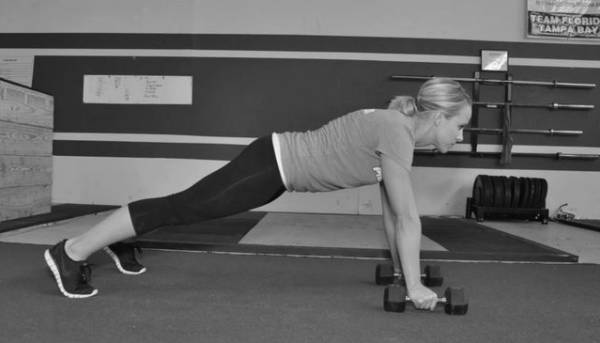
Step 2
A portion of the subject’s upper body (shoulder, chest, bicep, etc.) must touch the floor or both dumbbells. At this stage the subject should ascend back to the forward leaning rest position.
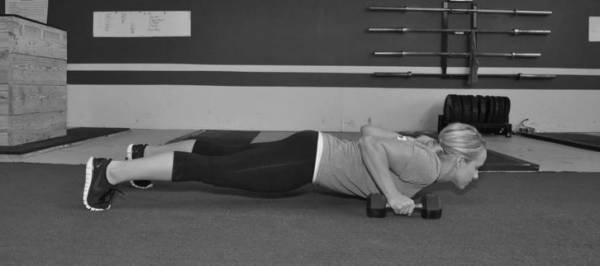
Step 3
The subject must fully extend both the elbows and not exhibit any sagging or excessively high hip position. (i.e., subject’s body line should be in a plank position).
Step 4
The subject will row the right-side dumbbell until it touches a portion of the upper body (shoulder, chest, bicep, etc.). Then the subject will lower the weight until they achieve the forward leaning rest position.
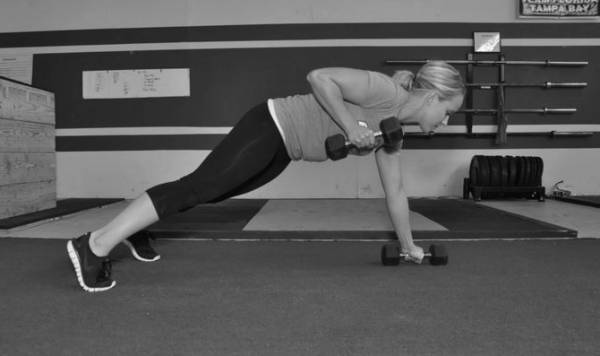
Step 5
The subject will row the left-side dumbbell until it touches a portion of the upper body (shoulder, chest, bicep, etc.). Then the subject will lower the weight until they achieve the forward leaning rest position.
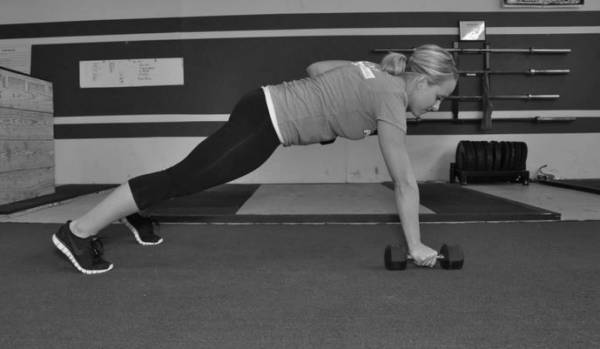
Step 6
The subject prepares for the next movement, which is a dynamic hop. At this step the subject may adjusting foot, dumbbell, or hip positions, etc. in preparation for the hop.
Step 7
The subject is required to complete a dynamic hop starting from the forward leaning rest position, ending in the position below. The feet should end up shoulder width or wider and slightly flared out. This movement is optimal from an efficiency standpoint and helps the administrator assess flexibility and athleticism.
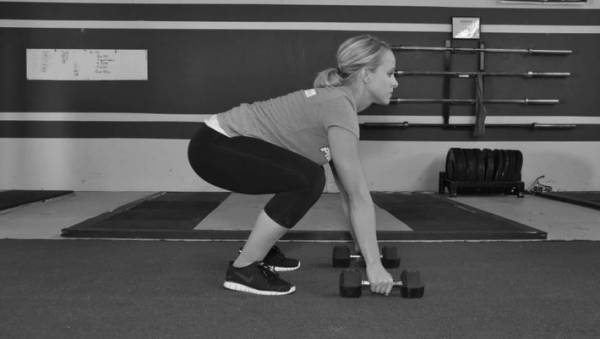
Individuals who are poorly conditioned, immobile, obese and/or uncoordinated may use a step-up (lunge) in lieu of a hop. This amended movement should be notated in the comments section of the scorecard.
Step 8
The subject completes the hop in an upright standing position. The dumbbells should be raised (power cleaned or curled) into a front rack position with a neutral grip. The head of the dumbbell should be in contact with the front of the deltoid. At this time the subject should prepare for the descent into a front squat by making any necessary adjustments to foot position, dumbbells or hips, etc.
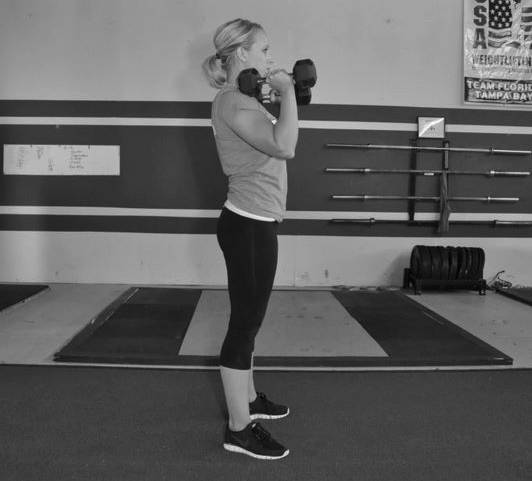
Step 9
The subject’s feet should be slightly wider than shoulder width and slightly flared out. At this time the subject will lower himself or herself into a front squat. The crease of the subject’s hip should be below the subject’s patella for scoring purposes. Once this standard is met the subject will ascend until the hip is completely open and the knees are locked out.
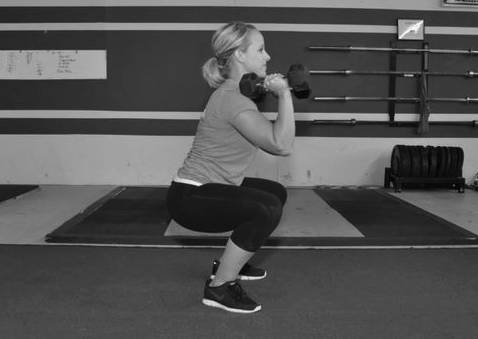
Step 10
The subject places the dumbbells directly overhead (via press, push press, jerk or thruster) with elbows completely locked out. Individuals who exhibit tight shoulders may have difficulty with this step. However, orthopedic dysfunction is a component on this test and these individuals will be held to the same standard. If the subject has difficulty with this step please notate in the comment section of the scorecard.
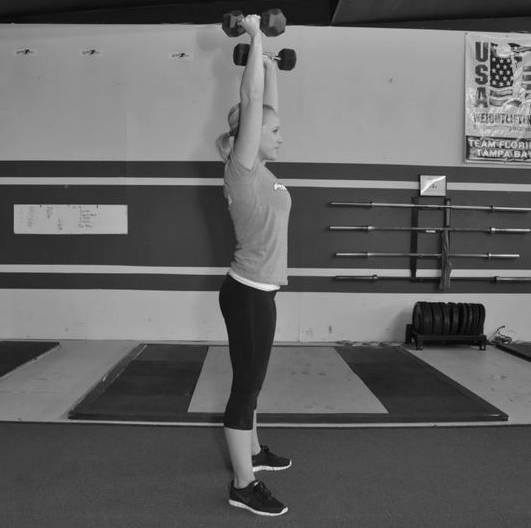
Step 11
Return to the front leaning rest position in a controlled manner. Be sure to place dumbbells down in a controlled manner in order to avoid injuring the wrist.
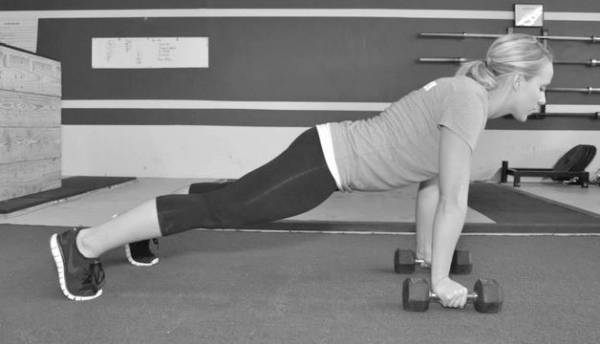
How to Score the Work Capacity Test
At the completion of five minutes immediately ask the subject what his or her rate of perceived exertion (RPE) is in relationship to the test. The RPE is scored on a on a scale of one to ten. The number of total repetitions and RPE should be recorded on the individual’s scorecard.

Using the WCT as a Screening Test for New Clients
As you can see, the WCT is a simple way of establishing a baseline of work capacity through scoring. However, it’s important to keep in mind that the subjective elements of the test are important, as well. For example, the test helps detect mobility and stabilty issues present with certain clients, while also giving you the ability to see how well people follow directions.
These observational examples can give a coach valuable insight into what makes a trainee tick. When we couple the subjective elements with the objective data it often leads to a meaningful dialogue between the coach and client. So, although this test was initially designed as a baseline fitness test, it can easily transition to a screening tool.
It’s important to keep in mind that when using the WCT as a screening tool there is a pass/fail standard of five reps. Many of you may think five reps in five minutes is absurdly easy, but I’ve seen people fail to achieve this standard countless times. Individuals who are unable to meet this objective are often severly deconditioned and/or obese and should not be placed in a group training enviorment.
Ultimately, there is no perfect test to measure a person’s overall fitness. However, the WCT offers a solid compromise on many fronts and it’s holistic nature gives the astute trainer an effective testing tool. At the end of the day, every trainee needs to know where they are in terms of overall fitness and the WCT helps us validate the efficacy of our training regimin with pre- and post- testing.
So, if you think you’re up to it, give the WCT a shot. I think you’ll find it an invaluable way to gauge your progress on your fitness journey or that of your clients on theirs. If you try it, post your score to the comments below.
Photo 1 courtesy of CrossFit Empirical.






